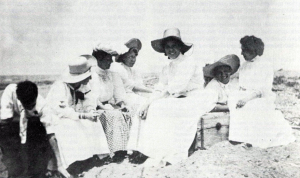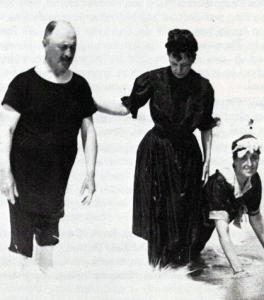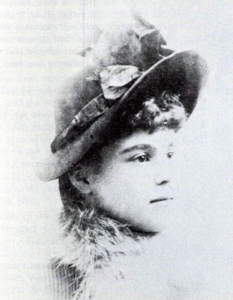Main Body
Millionaires’ Row: Migrations

Having walked you through our mansions, danced you through our social life, and included you in our daily doings -I must pause to tell you about our times spent away from Millionaires’ Row. Summer and winter vactions, as well as cultural excursions, were an important ingredient in our lifestyle.
In summer time, some people did go east to the seashore. But, remember, we had beautiful Lake Erie within easy reach; many summer colonies developed right around here.
Bratenahl began as such a summer enclave, evolving eventually into a community of elegant permanent estates. Lakeshore Boulevard, beginning just east of Gordon Park and hugging the lakeshore, was a beautiful road, embraced by an archway of trees. The roadway was quite quaint, lighted by gas lamps. A man would come along every late afternoon just about dusk to light the lamps. He had a little horse-drawn cart and would stop at each lamp post. Every morning he would return to turn off all the gaslights.
One of the lovely summer homes was that of the Holden family, set amidst very spacious grounds abutting the lake. Just to the east of the Holdens was the summer establishment of Mr. and Mrs. Warren Corning. He was my uncle, for whom I was named. I say summer ‘establishment’ because the Comings’ place was fairly typical of these summer spots. There was one large permanent building which served as a kitchen/ dining room facility. The balance of the accomodations was a tent colony! There were huge canvas tents with hardwood oak floors about two feet off the ground. Inside, these tents were furnished with beautiful mahogany dressers and brass beds. More tents could be erected to accomodate their out-of-town children and guests. This pasha’s paradise was the scene of gay entertaining and waterfront fun. Uncle Warren Corning had a steam yacht that was moored back of a long breakwater in front of his property. Sometimes the yacht was moored in the little creek (called Dugway) that ran between the Corning property and what is now Bratenahl Place. The Corning steam yacht was the vehicle for many enjoyable parties. Often we would sail across Lake Erie over to Canada and then come back late in the afternoon in time for supper.
Next to the Corning property, to the east, was the original Cleveland Golf Club, with a nine-hole course. When that clubhouse burned down, it was rebuilt as the Country Club of Cleveland, and later expanded to an l8-hole course (now the site of Bratenahl Place). Immediately next to the Country Club was the large summer residence of Mr. Howard Hanna, followed along the shore by the homes of his two sisters, Mrs. Haskell and Mrs. Harvey. Then came the lovely summer residence of Mr. and Mrs. Samuel Mather, known as “Shoreby”, and then the fabulous place of his half-brother, Mr. William G. Mather -“Gwinn”. Its beautiful gardens and regal house are still maintained, being used for civic purposes.
The iron freighters in those earlier days were much shorter in length than modern-day vessels, enabling them to hug the shore. This made their passage very visible to all the summer residents of Bratenahl and became a source of our entertainment, watching their passage.
Just beyond Bratenahl was a section called White City, a small amusement park with an excellent beach; a fine place for summer entertaining. Then came the larger Euclid Beach Park.
Among the popular summer “Club” colonies that developed, I recall the Wickliffe-on-the-Lake Club, where our family spent many summers. The cottages of the members were built in a half-circle formation around the main clubhouse on a very large green lawn that extended down to the lakefront. My father’s cottage was the one nearest the lake. The clubhouse furnished all meals and maintained the excellent standards demanded by its prominent members. Besides the lovely beach along clean Lake Erie, there was a fine swimming pool and two excellent tennis courts. Every Saturday evening there was a dance in the clubhouse. The Lakeshore division of the Cleveland, Painesville and Eastern Railway ran out along the shoreline, taking one to the Wickliffe Club.
On Labor day, 1911, I entertained a group for a roundrobin tennis tournament. My guests were there at the Wickliffe Club for lunch and dinner. After dinner, we had a huge party on the beach with a crackling bonfire, and many went in swimming again. And so our summers went.
My favorite club was Little Mountain Club, and I was lucky to often have an invitation from one of the members to stay out there. In the early days, before automobiles were in use, people would take the Lakeshore, Michigan and Southern Railroad to Mentor. Upon arrival there, they were met by a handsome coach that seated fourteen. It was built expressly for the Little Mountain Club members and their guests. Several hotels were built on the mountain when Mr. Randall P. Wade organized the Club. Some of the early shareholders were Joseph Perkins, Samuel L. Mather, Charles Hickox, George Worthington, and J. H. Wade. A charming church was built for the community. Bishop Leonard gave the funds and the Club gave the land; the members commissioned exquisite stained glass windows from Munich to decorate the church.
Set in a forest of centuries old pines and giant hemlocks, the scent of pine glorified the air . In spring, the wild flowers spread their perfume. We often enjoyed picnics by Devil Kitchen Cave and Table Rock Cave, drinking from the sparkling springs. The Little Mountain Club house was an enormous, rambling building with porches extending across the entire front. Surrounding it were the privately owned cottages with quite spacious accomodations featuring several bedrooms and large porches.
The Mathers owned one of these cottages, and my old friend Livingston Mather invited me out there often. The quartet in which we both sang was invited there for an annual overnight houseparty. “Liv” sang second bass; I was baritone.
Knob Hill was the private preserve of Dr. George Crile and was located right next to Little Mountain, with a carved valley separating the two properties. Dr. Crile bought 2,000 acres on Knob Hill in 1914. For living quarters, he had tents sent from India that were designed for army officers. Inside each tent there was a division for dressing, and a bedroom. Outside each canvas apartment was a small porch with an awning. The Criles built a large main house with a dining room, kitchen and two bathrooms.
From Ambercrombie and Fitch in New York, Dr. Crile ordered a sun house (made of sassafras wood) for the Knob. He gave this magnificent house to his son, “Barney” Crile, when he was just eight years old. A trail on their property went almost all the way to Painesville. White pine, white birch, hemlock and other majestic trees bordered the trail, in the spring, the mountain laurel and dogwood trees bloomed, adding color along the way.
Another private playland was the Mather’s Mountain Glen Farm. Mr. Livingston Mather used to entertain an annual house-party over the Fourth of July weekend, inviting his Yale 1905 classmates. Although Yale ’09, I was invited much to my pleasure. I presume one of the reasons I was always included was because I helped entertain the group with my singing and dancing. “Liv’s” large lake at Mountain Glen Farm was ideal for swimming and boating. “Liv” invented the game of water baseball; I know of no other place where the game was played on water. He had a large raft for the team up to bat and the catcher of the opposing team. Other rafts were anchored for the pitcher as well as the three basemen. The three out-fielders swam in free water. The ball was baseball size but made of cork, thus very resilient. When the batter hit that ball it went with great speed and distance out into the lake. Such were the special pleasures of these pastoral retreats; the memories of those happy days remain.
Billy Hale’s family had a lovely cottage at the private Middle Bass Club on the island in Lake Erie. You recall that Billy was one of my buddies in the “SSS” Club. He invited us, the club members, to go to the island as soon as University School was recessed, about June 10. Our parents thought that we boys would be taking our meals at the Clubhouse and living in the Hale cottage. We thought so, too -until we arrived on Middle Bass Island and discovered the Club wasn’t open for meals until the end of June!
One of our “SSS” members thought it would be a great adventure if we rowed over to nearby Rattlesnake Island and camped out. So, commandeering a small rowboat of the Hale’s, rigging up a mast and putting up a sheet for a sail, off we went. We had enough foresight to stock the boat with food before setting sail.
We arrived on Rattlesnake Island and had lots of fun scaring ourselves exploring the old abandoned house that,_ reportedly’, had become ‘haunted’. There was a small ideal harbor; and from one point to the other we stretched a clothesline . .. and ran up the American flag, claiming the territory.
The second day in camp, one of the boys suddenly shouted: “Wickie, for God’s sake, there’s a rattlesnake right next to you!” I looked back. The island was true to its name. I can see it as well as if it were yesterday: coiling around me, its head was moving fast, deciding where to strike. Well, I think I broke all records for the ten yard dash. And almost immediately we all threw rocks at it and killed it. Then we soaked it in salt water, skinned it, and mounted it on an oak panel. We brought that rattler back to the “SSS” clubhouse and mounted it over the fireplace in our Iivingroom.
Wintertime inspired a different set of vacation requirements: a warm climate was surely at the head of the list. Mr. Henry Flagler of Cleveland was the first man of wealth and vision to discover Florida as a playground. He took his sick wife there for the winter in 1878. He invested his large Standard Oil fortune in Florida and became one of the greatest developers in our history. He established his empire on the east coast of Florida and in 1888 built the fabulous Ponce de Leon Hotel in St. Augustine, costing over two and half million dollars. His friend, Henry B. Plant, built on the west coast of Florida the Tampa Hotel, of Arabic, Moorish-Turkish architecture. It cost him more than two million dollars for his enterprise. Florida was now ready to lure all the northern and western gentry looking for a warm spot in the winter.

But, there were other temperate zones attracting a following. Thomasville, Georgia became very popular in the 1800’s, with its Piney Woods Hotel and Mitchell House, both featuring striking architecture and luxurious accomodations. The Hanna family was one of the first from Millionaires’ Row to stop in Thomasville in the last century. Mr. R. Livingston Ireland, Jr. was a delicate child and his mother took him out of school to spend the winters in Thomasville where he was tutored.
Many Cleveland families still maintain homes there. These winter plantations include several plots of several hundred acres ideal for shooting quail, dove and wild turkey.
Many of the Cleveland polo players spent their winters in Camden, South Carolina. It was while Mr. Walter White was staying in Camden he met the lovely Virginia Saunders, who became his wife. Aiken and Camden polo fields were usually dry enough to play on. The soil was sandy, and, if it did rain in the morning, it would be dry by afternoon.
During one of our sojourns in South Carolina we had the pleasure of meeting Mr. Archibald Rutledge. A well-known author, he was the Poet Laureate of South Carolina. Tall and handsome, with an aesthetic face, he looked every inch the poet.
He spun Southern yarns all through the evening. The following best illustrates how the colored people on his plantation had the utmost faith and confidence he would always take care of them:
Nathan was responsible for Mr. Rutledge’s wood pile, and for cutting and splitting the fat wood and logs. They were intended for the many fireplaces he had in his large pre-revolutionary house. The wood pile was diminishing at a rapid rate, and Mr. Rutledge knew Nathan was giving away the logs and fat wood to his many friends living in other cabins on the plantation. Mr. Rutledge was planning to let Nathan go if he kept on giving away his wood.
He said to Nathan, “I really don’t like the way my wood is disappearing so rapidly, and, if this continues, one of us must go.”
Nathan replied, sadness in his voice: “Oh, Marse Archibald, don’t ever leave here; for who would take care of us?”
We had a winter residence in Camden, South Carolina; the pre-revolutionary houses were built of cyprus wood. The lovely old brick came over from England on the ships, having been carried as ballast. The South Carolinians used the brick for their slave quarters, as the brick was not valued at the time.
On our long verandas were joggling boards. These were two-inch thick boards cut from the center of pine trees; about 20 feet long and three feet wide. The boards were slipped into wooden horses set at each end. When you sat in the middle of a board, there was quite a spring to it. A very good seat for lovemaking; for no matter how far apart the couple sat, they always ended up sitting side by side in the middle of the board. We were not allowed though to joggle on Sundays when we were young, as we made too much noise bouncing up and down.
There were steel pipes installed in places along the verandas to support the heavy roots of wisteria and the large lavender blossoms cascading down toward the ground. Since these old houses originally had no furnaces, we had eleven fireplaces in our Camden home. The fires would be lit and the doors of the different rooms closed to keep warm. I still remember how cold those high-ceilinged hallways felt!

Besides these established retreats there was always the shopping spree or theater trip to New York City, enlivening any time of the year. My parents and their friends liked New York in the fall; many Clevelanders stayed at the old Waldorf Hotel on Fifth Avenue. Oscar, who was head of banquet service there, planned elaborate dinner parties for them. My mother told me about the 28·page menu at Sherry’s beauti· ful restaurant.
My mother’s days in New York were largely spent Christmas shopping, looking for clothes and seeing old friends. My parents went to the theater every night to see the new fall openings on Broadway.
My niece, Anne Hickox, was taken to Tiffany’s by her father when she was a child. There wasn’t any jewelry suitable for her in that elegant store, though. She told her father what she really wanted was an alarm clock. The pompous clerk at Tiffany’s acted very offended.
My cousin, Adele Corning Chisholm, told the story about the time her mother and Mrs. Mark Hanna went to New York for a little spree of theater·going and shopping. They went upstairs after dinner to put on their bonnets to go out to the theater. They found, pinned on the cushion, a piece of paper on which was written, “Lead us not into temptation. Signed, the Chambermaid.” After that, they were careful to put away their valuables. Adele was a little girl when she first heard that story; she never forgot it.
So, it seems that life at the turn·of·the-century was fairly cosmopolitan -at least for those of us who lived on Millionaires’s Row. We had a great variety of adventures, and, when the world could not come to us, we sought it out according to our interests and perferences. Coming back from wherever we may have been, surely the itinerary up aide Euclid Avenue was still the most beautiful of all . . .
